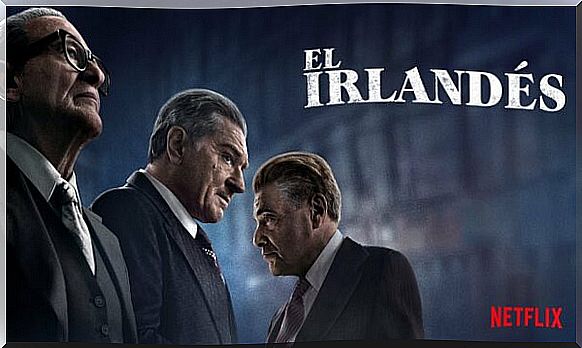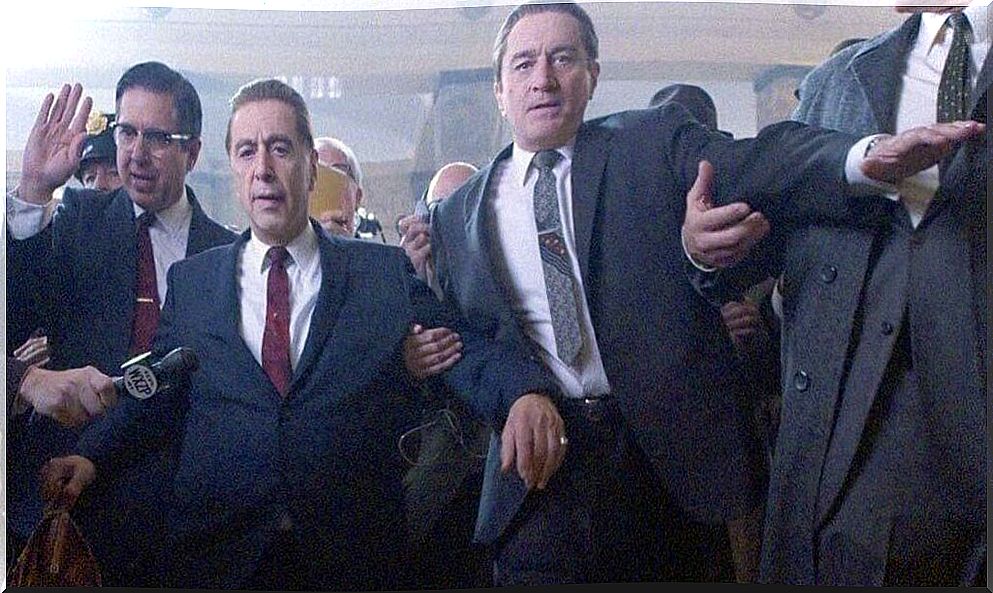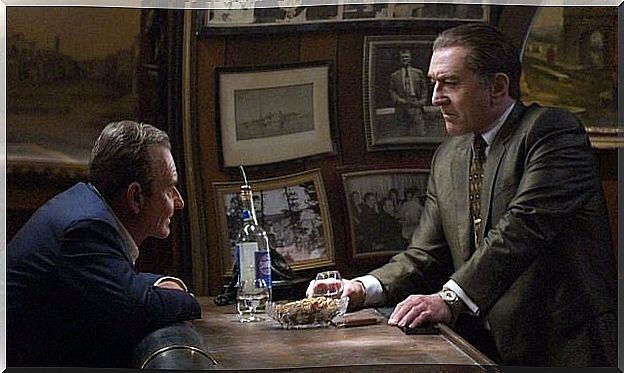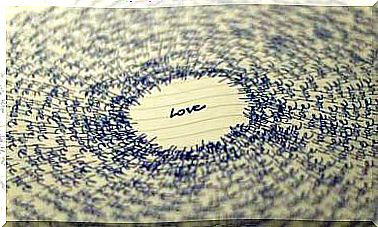The Irishman: A Door Ajar

Martin Scorsese is a living legend in film history. The filmmaker, at 77, has an immense filmography; in his case, the ” if brief, twice good ” is not a reality.
Extensive films, of a very diverse nature and after decades in operation. Scorsese signs some well-known and applauded titles such as: Taxi Driver (1976), One of Ours (1990), The Departed (2006), The Cape of Fear (1991), Casino (1995), The Wolf of Wall Street (2013) and others as controversial as The Last Temptation of Christ (1988).
Recently, his name has been on everyone’s lips, his harsh criticisms of superhero films have covered covers that coexist with the applause received for his latest feature film: The Irishman (2019). A film with which Scorsese travels a well-known path: that of gangsters, the Italian-American mafia and the United States in the middle of the 20th century. However, age and the passage of time have given the filmmaker a new perspective, a new twist.
The Irishman is a job in which Scorsese is “in his sauce”, he plays at home so to speak. His cast includes acting veterans who, like him, have proven to be still in top form.
The Irishman: a trip to the past
The Irishman is a trip to the past in the strictest sense of the word, it addresses a historical past that goes back, specifically, to the already distant 20th century. However, it is a trip to the past also in a less literal sense, as it is one of the longest films of the last decades.
We live in a time when cinema has been partly overshadowed by series. We would rather “marathon” a series than go to the movies. A cinema in which, in addition, there are not many titles that exceed two hours.
The new generations have grown up differently, we no longer have to go to the cinema if we want to see a movie, we can pause it to go to the bathroom whenever we want, watch it in two days, etc. Pure entertainment is at the service of all and, although from time to time it gives us unforgettable titles, it seems to have become something that surpasses art, relegating it to the background.
Scorsese had a project in mind, but no Hollywood production company accepted it, so he had no choice but to adapt to the demands of the new scenarios: streaming platforms .
Netflix decided to move forward with its project, a project that can be seen as the “least Netflix” in the world, but which, nevertheless, finds its best way of dissemination on the platform. And, after all, Netflix fits everything, from real jewels to the equivalent of fast food in the audiovisual world.
Thus, the paradox is produced and the film, which evokes the old gangster films, which takes us back to the last century and which comes from the hand of several elderly men, but with creativity still on the surface, ends up being developed in the most current medium and reproduced on small devices that are far from the huge cinema screens.
Although Scorsese strongly recommends that we not watch the movie on a smartphone , but rather enjoy it on the largest screen possible, in an afternoon when we have nothing to do and without being interrupted by the phone.
In short, he proposes us to return to the past, to that moment when cinema was a moment of delight.
A true story
The mafia, especially the Italian-American one, has captured some of the greatest stories in cinema: from films that have been revalued over time like Once Upon a Time in America (Sergio Leone, 1984) to well-known titles like The Godfather (Coppola, 1972).
Scorsese already ventured into the genre with: Malas Calles (1973), which was also his first collaboration with De Niro; Casino (1995) and One of Ours (1990).
Both Scorsese and the protagonists of the Irishman belong to a generation born in the 1940s; specifically in New York, except Pesci who comes from New Jersey. All of them are Italian-American and some grew up in the Little Italy neighborhood.
Scorsese has always felt deeply rooted in his heritage , as he portrayed it in the documentary Italianamerican (1974) and today, many years later, he returns to his origins, to those stories that, despite being real, seem to be taken from the purest fiction .
The Irishman investigates a real character and immerses himself in history : from the rise and subsequent assassination of Kennedy to the mysterious disappearance of Jimmy Hoffa, the union leader who caused so much talk in the middle of the 20th century. And, in all this, there is a background, a nexus headed by the interests of the mafia of which the Irish protagonist is a collaborator in charge of “painting walls”.
Bloodstained walls, quick clean kills, shot while a car waits outside a restaurant to take its hit man to safety. Pistols drowned in water, silenced by the fastest killer Scorsese has ever presented.

Not without giving up a certain black humor and risky conversations that are already a “house brand”, being, even so, the slowest of his films. Taco-studded, yet laid-back, mature, and a far cry from the breakneck pace of One of Ours or more recent films like The Wolf of Wall Street .
It is the story of Frank Sheeran, a royal person accused of having belonged to the mafia; the history of Hoffa’s disappearance and, ultimately, the silenced history of 20th-century America. But beyond being a gangster story, Scorsese has matured, and his maturity is reflected in his characters, in the way he goes through, through flashbacks , a personal story.
A story of power, of “tough guys” who, finally, are nothing more than old men plagued with ailments playing petanque in a prison yard.
A film headed by the greats of the genre, by a Joe Pesci who, despite being retired, almost reluctantly accepted a role in which he dazzles, a De Niro that we all associate with the mafia and a Pacino who, although he had not worked with Scorsese, keep evoking the glory of the Godfather .
The Irishman : a film to remember
I bet that, in a few years, we will continue to remember the film and that, perhaps, it will even revalue. If we can blame the film for something, it is the use of new technologies to rejuvenate actors who, far from needing to demonstrate their immortality, should make the most of their experience.
The use of digital rejuvenation has been harshly criticized; perhaps, it would have been better to hire young actors for the flashbacks , or perhaps, to reduce their duration. We see De Niro without wrinkles, but his body and his movements seem to tell us otherwise.
The film is a kind of fusion between the old and the new. The old by its essence, by the maturity of its creator and their faces, but the new in its dissemination and production.
With 10 nominations for the Oscars, among which are best film and best director, The Irishman leaves no one indifferent. Either because of the magnitude of it, because of the incredible way of directing our gaze or because of the scarce female presence; something that seems to be already a hallmark of the house.
Female roles are residual in almost all of his cinema; a filmography in which “tough guys” predominate.
However, far from reproaching him, in the case of The Irishman , we recognize a time, a time long ago in which the woman was nothing more than the mere decoration of her husband. And, even with everything, there is a female character that stands out throughout the entire film: the protagonist’s daughter who, from the beginning, shows a certain repulsion towards her father’s activities.
Silently, but harshly, he ends up gaining prominence in the final part, at which point Sheeran is already old, his friends have passed away, his wife too, and he only has his daughters left, all of them women, although they seem determined to keep distance with his father.

Scorsese is a great storyteller, capable of saying with images the ineffable with words; capable of portraying and capturing through his camera what is latent in each character.
Despite its duration, The Irishman manages to conquer us, keep us hooked on the screen to know how the life of our protagonist ends, a man trapped by the webs of a spider web from which he will not be able to escape.
The Irishman offers us a journey through various stages of life, an introspective journey of a character linked to his past, but who, like every human being, is condemned to die. The reflection of his actions is manifested in his lonely old age and in a door ajar that leaves the viewer reflecting, in a quasi-cathartic state that he cannot quite identify.
Have we seen a typical gangster film? Have we witnessed a journey into the human being? Why a door ajar? The future, death, destiny, perhaps, are just that: a door ajar.
Netflix main image









